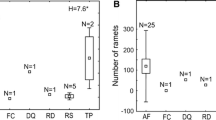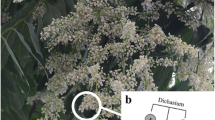Abstract
Dwarf bamboos in the genus Sasa are believed to be long-lived, synchronously flowering, and monocarpic plants. However, the monocarpy of dwarf bamboo has not been confirmed, because whether all ramets within one genet flower at the same time cannot be determined without differentiating the genetic structure among ramets. This study aims to evaluate the reproductive traits of Sasa pubiculmis by verifying the monocarpy and physiological integration between flowering ramets and non-flowering ramets during a 4-year flowering period. One genotypically identified genet, which covered an area of approximately 3 ha, had both flowering and non-flowering patches of ramets during the 4-year flowering period (2004–2007). A fraction of the flowering genet remained non-flowering during the 4 years of observation, and did not die after mass flowering. Flowering ramets were physically connected to non-flowering ramets via rhizomes, and assimilated 13C was allocated from non-flowering ramets to flowering ramets. Consequently, we clarified that this dwarf bamboo potentially has polycarpic reproductive traits rather than monocarpic, and a genet can keep rhizomes and non-flowering patches alive to sustain the organism after mass flowering.


Similar content being viewed by others
References
Abe M, Miguchi H, Nakashizuka T (2001) An interactive effect of simultaneous death of dwarf bamboo, canopy gap, and predatory rodents on beech regeneration. Oecologia 127:281–286
Alpert P, Mooney HA (1986) Resource sharing among ramets in the clonal herb, Fragaria chiloensis. Oecologia 70:227–233
Campbell JJN (1985) Bamboo flowering patterns: a global view with special reference to East Asia. J Am Bamboo Soc 6:17–35
Evans JP (1992) The effect of local resource availability and clonal integration on ramet functional morphology in Hydrocotyle bonariensis. Oecologia 89:265–276
Fukuzawa K, Shibata H, Takagi K, Nomura M, Kurima N, Fukazawa T, Satoh F, Sasa K (2006) Effects of clear-cutting on nitrogen leaching and fine root dynamics in a cool-temperate forested watershed in northern Japan. For Ecol Manage 225:257–261
Gadgil M, Prasad SN (1984) Ecological determinants of life history evolution of two Indian bamboo species. Biotropica 16:161–172
Hartnett DC, Bazzaz FA (1983) Physiological integration among intraclonal ramets in Solidago canadensis. Ecology 64:779–788
Hasegawa T, Kudo G (2005) Comparisons of growth schedule, reproductive property and allocation pattern among three rhizomatous Polygonatum species with reference to the habitat type. Plant Species Biol 20:9–18
Hasegawa S, Koba K, Tayasu I, Takeda H, Haga H (2003) Carbon autonomy of reproductive shoots of Siberian alder (Alnus hirsuta var. sibirica). J Plant Res 116:183–188
Hiura T (2001) Stochasticity of species assemblage of canopy trees and understory plants in a temperate secondary forest created by major disturbances. Ecol Res 16:887–893
Hiura T (2005) Estimation of aboveground biomass and net biomass increment in a cool temperate forest on a landscape scale. Ecol Res 20:271–277
Hiura T, Sano J, Konno Y (1996) Age structure and response to fine-scale disturbances of Abies sachalinensis, Picea jezoensis, Picea glehnii, and Betula ermanii growing under the influence of a dwarf bamboo understory in northern Japan. Can J For Res 26:289–297
Hiura T, Fujito E, Ishii T, Naniwa A, Sugata S, Ishida K, Murakami M, Kato E, Maeno H, Fukushima Y, Sakai T (1998) Stand structure of deciduous broad-leaved forest in Tomakomai Experimental Forest, based on large-plot data. Res Bull Hokkaido Univ For 55:1–10
Janzen DH (1976) Why bamboos wait so long to flower. Annu Rev Ecol Syst 7:347–391
Keeley JE, Bond WJ (1999) Mast flowering and semelparity in bamboos: the bamboo fire cycle hypothesis. Am Nat 154:383–391
Kelly CK (1995) Thoughts on clonal integration: facing the evolutionary context. Evol Ecol 9:575–585
Kitamura K, Kawahara T (2007) Flowering culm dynamics in sporadic flowering of Sasa cernua Makino. Bull FFPRI 6:239–244
Kobayashi M, Nomura T (2001) Emergence of regenerated culms of Sasa jotanii (Poaceae: Bambusoideae) after two years of monocarpic mass flowering in Mikurajima Island, Izu Islands, Japan (in Japanese with English summary). Bamboo J 18:37–44
Makita A, Konno Y (1989) Sporadic flowering of Sasa senanensis Rehder in Nopporo, Hokkaido, Japan (in Japanese with English summary). Rep Fuji Bamboo Garden 33:50–60
Makita A, Konno Y, Fujita N, Takada K, Hamabata E, Mihara T (1988) Mass flowering of Sasa tsuboiana in Hira mountains (in Japanese with English summary). Bamboo J 6:14–21
Makita A, Abe M, Miguchi H, Nakashizuka T (2004) Population dynamics of Sasa kurilensis for 8 years after mass flowering to the south of Lake Towada, with special reference to the non-flowered populations (in Japanese with English summary). Bamboo J 21:57–65
McClure FA (1966) The bamboos: a fresh perspective. Harvard University Press, Cambridge
Miyazaki Y, Hiura T, Funada R (2007) Allocation of photo-assimilated 13C from reproductive and non-reproductive shoots to fruits in Styrax obassia. Plant Species Biol 22:53–57
Mooney HA (1972) The carbon balance of plants. Annu Rev Ecol Syst 3:315–346
Nakashizuka T (1988) Regeneration of beech (Fagus crenata) after the simultaneous death of undergrowing dwarf bamboo (Sasa kurilensis). Ecol Res 3:21–35
Nishiwaki A, Makita A (1998) Seed reproduction in the mass flowering sites of Sasa kurilensis var. jotanii in Mikura-jika, Izu Islands, Japan, in 1997 (in Japanese with English summary). Bamboo J 15:1–9
Obeso JR (2002) The costs of reproduction in plants. New Phytol 155:321–348
Poorter L, Zuidema PA, Pena-Claros M, Boot RGA (2005) A monocarpic tree species in a polycarpic world: how can Tachigali vasquezii maintain itself so successfully in a tropical rain forest community? J Ecol 93:268–278
Saha S, Howe HF (2001) The bamboo fire cycle hypothesis: a comment. Am Nat 158:659–663
Saitoh T, Seiwa K, Nishiwaki A (2002) Importance of physiological integration of dwarf bamboo to persistence in forest understorey: a field experiment. J Ecol 90:78–85
Saitoh T, Seiwa K, Nishiwaki A (2006) Effects of resource heterogeneity on nitrogen translocation within clonal fragments of Sasa palmata: an isotopic (15N) assessment. Ann Bot 98:657–663
Sakai T, Akiyama T, Saigusa N, Yamamoto S, Yasuoka Y (2006) The contribution of gross primary production of understory dwarf bamboo, Sasa senanensis, in a cool-temperate deciduous broadleaved forest in central Japan. For Ecol Manage 236:259–267
Shibata H, Kirikae M, Tanaka Y, Sakuma T, Hatano R (1998) Proton budgets of forest ecosystems on volcanogenous regosols in Hokkaido, northern Japan. Water Air Soil Pollut 105:63–72
Silvertown JW (1980) The evolutionary ecology of mast seeding in trees. Biol J Linn Soc Lond 14:235–250
Simmonds NW (1980) Monocarpy, calendars and flowering cycles in Angiosperms. Kew Bull 35:235–245
Stephenson AG (1981) Flower and fruit abortion: proximate causes and ultimate functions. Annu Rev Ecol Syst 12:253–279
Suyama Y, Obayashi K, Hayashi I (2000) Clonal structure in a dwarf bamboo (Sasa senanensis) population inferred from amplified fragment length polymorphism (AFLP) fingerprints. Mol Ecol 9:901–906
Vos P, Hogers R, Bleeker M, Reijans M, Lee T, Hornes M, Friters A, Pot J, Paleman J, Kuiper M, Zabeau M (1995) AFLP: a new technique for DNA fingerprinting. Nucleic Acids Res 23:4407–4414
Wada N (1993) Dwarf bamboos affect the regeneration of zoochorous trees by providing habitats to acorn-feeding rodents. Oecologia 94:403–407
Acknowledgments
We thank Prof. E. Shibata for assisting with the arrangements for the field survey; Drs. K. Ishida and K. Hirayama for laboratory support; Messrs. T. Ishii, A. Okuda, K. Ichikawa, S. Okuyama, and the staff of the TOEF for assisting with the arrangements at the study site; Drs. H. Miyasaka, H. Doi, and Prof. S. Nakano for permitting and supporting the stable isotope analysis; Drs. Y. Konno, K. Takahashi, A. Makita, M. Kobayashi and K. Yonekura for taxonomic identification of the study species. This study was supported in part by Grants-in-Aid for Scientific Research (15208014 and 18380090).
Author information
Authors and Affiliations
Corresponding author
Rights and permissions
About this article
Cite this article
Miyazaki, Y., Ohnishi, N., Takafumi, H. et al. Genets of dwarf bamboo do not die after one flowering event: evidence from genetic structure and flowering pattern. J Plant Res 122, 523–528 (2009). https://doi.org/10.1007/s10265-009-0241-9
Received:
Accepted:
Published:
Issue Date:
DOI: https://doi.org/10.1007/s10265-009-0241-9




